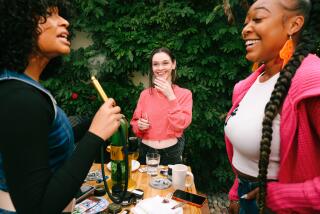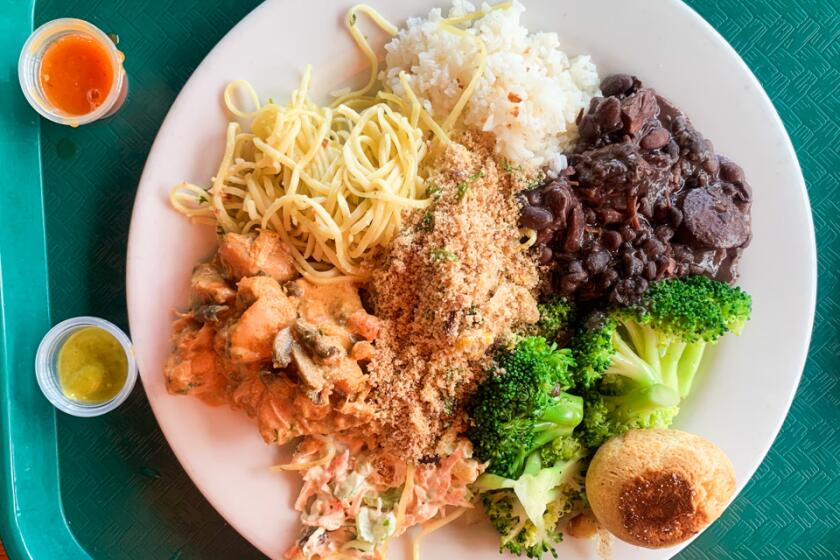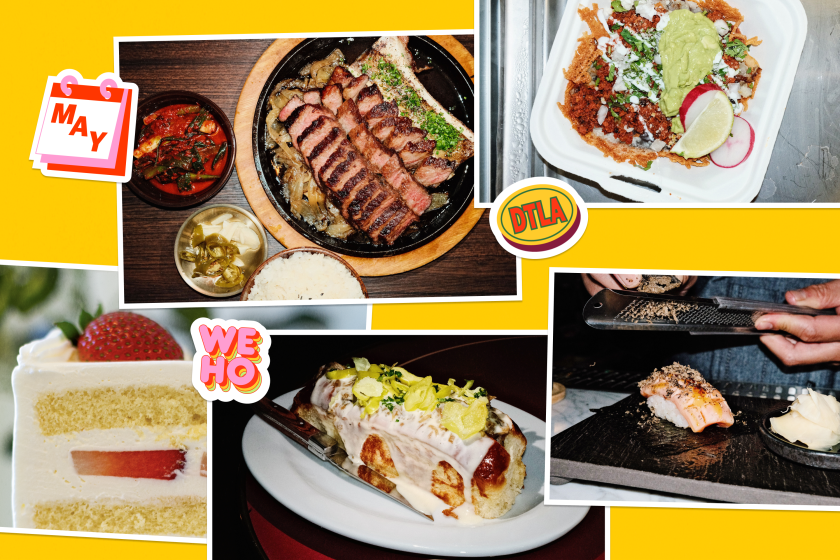LetterPress Chocolate makes outstanding bean-to-bar chocolate in a Cheviot Hills apartment
Imagine a chocolate factory, and you probably think of Valrhona or Godiva, Hershey’s or Cadbury or even Roald Dahl’s fictional playhouse: a massive wonderland built of cacao. By contrast, David and Corey Menkes run LetterPress Chocolate out of their two-bedroom, 900-square-foot, second-floor apartment in Cheviot Hills. In that cramped space, the couple operates their minuscule bean-to-bar chocolate factory, making outstanding bars of chocolate in their kitchen, laundry room and living room.
Founded in 2014, LetterPress Chocolate produces micro-batches of single origin chocolate, with beans that David Menkes sources from mostly Central and South America. Menkes, who spends a lot of time at origin, finds and brings back fermented cocoa beans, then roasts them and grinds them in LetterPress’ “main nerve,” also known as his laundry room.
“Needless to say,” says David, “we’re actively looking for a warehouse.” At the moment, the couple -- they do not yet have other employees -- makes about 60 bars a day. Not bad, considering that Corey has an e-commerce day job, and that, before she had what might best be described as a chocolate epiphany, David spent 17 years as a graphic designer.
LetterPress operates in the Menkes’ apartment under an L.A. County Cottage Food permit. “I really think that was set up for someone who baked cupcakes or something,” says David, as he catalogs what bars are left, kept at 60 degrees in a wine refrigerator in the living room.
Jigsawed along the Menkes’ washer and dryer is a winnowing machine, designed by Santa Barbara chocolatier Michael Orlando of Twenty-Four Blackbirds Chocolate, which looks kind of like a MacGuyvered dryer instead of a crucial part of the chocolate-making process. In the kitchen, where neither David nor Corey has cooked anything for about two years, there’s no real food, but containers of cocoa nibs. One bedroom functions as a wrapping room.
On the large table that dominates the living room, there are three grinders — called melangers, these are actually made to be chickpea grinders for Indian dosas — churning chocolate; they’ll run for about 48 hours, during which David will add sugar, although he won’t be specific about when and how much (“trade secrets!”). The chocolate is then aged, which is done in a series of metal containers that are lined up on the table in front of a large flatscreen television, so that, presumably, the Menkes can check on their chocolate during commercial breaks. A blue Post-It note on one container reads “Temper me next!”
“There’s a little bit of alchemy to this,” says David as he watches the chocolate spin around the grinders, as some people would watch their laundry in a laundromat.
The Menkes did not set out to be chocolatiers, but a few years ago, they started “getting into chocolate.” They visited their first cacao plantation in 2012. “I became the guy at work,” says David, who worked for DreamWorks at the time, “who always had a bunch of chocolate on my desk.” In 2012, he and Corey started a chocolate blog, called Little Brown Squares, where they wrote about chocolate, eventually doing ad hoc tastings at work, as part of the DreamWorks Chocolate Society, because “chocolate makers started sending us all this chocolate.”
As a graphics designer, David’s next idea was not to make chocolate, but to make a documentary on cacao production. While he was discussing the project with Juan Bronson, a colleague and friend, Bronson told David that he’d quit the business — to take over his father’s cacao plantation in Guatemala. Kismet, maybe. Bronson’s farm is Izabal Agro Forest, a hardwood and cacao farm in Guatemala’s Lake Izabal basin, and it’s the origin not only for much of LetterPress’ chocolates, but LetterPress itself. “I liked the idea of getting involved at the very beginning,” says David.
But he first had to learn how to make the stuff, so he took a one-week long class in Hawaii run by Madre Chocolate called the Cacao Boot Camp. And then he came home to Cheviot Hills and started making his own chocolate, getting feedback by including his own stuff in the chocolate tastings at work.
“We did it totally blind. And everybody told us they hated it.” The Menkes kept experimenting, and six months later, people at the tastings started asking to buy their chocolate.
Now David, who is from Wrightwood, up in the San Gabriel Mountains, and his wife, who is from Highland, near San Bernardino — the couple met in high school — spend most of their time making chocolate.
The bars are mostly 70% cocoa, made from beans from farms in not only Guatemala, but Trinidad, Peru, Costa Rica and the Dominican Republic, and they sell from $10 to $15 a bar, or $45 or $55 for a limited edition pack of four. If that seems like a lot for a bar of chocolate, consider how the Menkes create these bars. And also what they taste like: This is extraordinary chocolate, intense and fruity, grassy or nutty, depending on the bean, and incredibly smooth, without the bitter finish that many high-percentage dark chocolates can have.
As for where to find it, you mostly have to order online, though you can buy it at Wally’s wine shop in West Los Angeles, at a few small shops in Eagle Rock, at the Nordstrom’s in San Francisco — and in the Netherlands, thanks to a Dutch supplier who tasted the stuff and fell in love with it.
David, who quit his graphics design job, says he’s better at wrapping the chocolate than his wife, so he does it all himself, wrapping each LetterPress bar (“it takes me 70 seconds”) by hand. And that wrapping? David designed that too, using a South American 1920s-era air mail stamp as a prototype, and printing the labels at a nearby office supply store. (For some single origin bars, he has actual stamps made on a 19th century perforating machine.)
If this all sounds terribly old school, check out LetterPress’ Instagram feed and you’ll find not only pictures of chocolate, but photos of printing presses: Both Menkes are docents at the International Printing Museum in Carson, the largest of its kind in the world. Which is why, of course, this apartment chocolate factory is called LetterPress in the first place.
As David sits on the unused bed in his wrapping room, he pulls out a few bars of chocolate from a square beer fridge in the corner, called an OPC fridge. This is where he houses “other people’s chocolate,” the stuff he keeps around for context and, presumably, if he and his wife get tired of all that take-out. There are bars of what he considers to be chocolate that’s way better than his, bars from Hungary and Missouri, many made from Venezuelan cacao — which he considers the best in the world.
“We don’t touch any beans from Venezuela, because I’d just screw it up.” In the meantime, he says, he and Corey eat other people’s Venezuelan chocolate and continue making their own. “We’ve been doing this for two years. I just want to get better.”
Because taking pictures of food is almost as much fun as eating it, on Instagram @latimesfood.
ALSO:
Where to get great chocolates for Valentine’s Day
The layer cake from proof is a sweet lesson in chocolate architecture
There’s a chocolate apothecary bar in Culver City with chocolate body oil
More to Read
Eat your way across L.A.
Get our weekly Tasting Notes newsletter for reviews, news and more.
You may occasionally receive promotional content from the Los Angeles Times.







